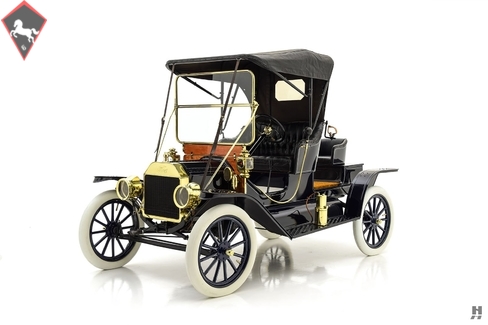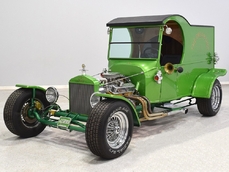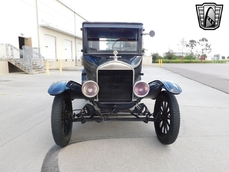Ford Model T Commercial Roadster 1912
Allgemeine Beschreibung :
Ford’s brilliant Model T represents the genesis of the modern automobile industry, making car ownership suddenly within reach for millions of people. Versatile and inexpensive, the Model T is a cultural icon and one of the most important inventions of the 20th century. The key to the Model T’s success was Henry Ford’s development of the moving assembly line, perhaps even more important than the car itself. The moving assembly line is one of the most significant industrial advancements of the Twentieth Century. Putting it into perspective, Henry Ford enjoyed reasonable success when he sold approximately 10,000 units of the Model S and Model K. After the advent of the moving assembly line, Model T production topped fifteen million by the end of 1927. For all of Henry Ford’s brilliance and dogged determination, he was also quite a pragmatist when it came to engineering. Design wise, the T wasn’t necessarily an innovative machine, and it didn’t change a great deal in eighteen years. It was designed to be built as quickly as possible, easily serviced, and above all, affordable. Even with the ingenious production methods taken out of the equation, the Model T stands proudly as a truly versatile machine that could perform many tasks beyond simple transportation. From racing cars to farm implements and industrial machinery, Model Ts have done it all.
While the basic formula of the Model T was unchanged from 1909 through the end of production in 1927, numerous detail changes made throughout the production run improved reliability, production efficiency, and reduced costs. One of the most obvious distinctions between early and late models was the use of brass. Brass detailing featured heavily on cars built before mid-1916, yet it gradually tapered off as later models featured more austere looking painted-steel radiator shells and nickel-plated bright work. Generally speaking, Brass-Era Model Ts are considered the more collectible of the bunch. In spite of their humble roots, they stand proudly among the most important collector cars, with examples found in hobbyist garages, private collections, and motoring museums the world over.
A desirable Brass-Era example, this 1912 Ford Model T wears the sporty and attractive Commercial Roadster body, one of six styles available that year. Ford made numerous running changes throughout production, and the transitional 1912 models proved to be the last for the original body style, and are considered by some as the pinnacle of early Brass Era Model Ts. Several significant changes took place in 1913, setting the pattern for the next dozen years of production.
Before Henry famously switched to all-black paint for the T (from approximately 1914-on), several colors were available varying by year and body style. Nearly all 1912 models wore a handsome shade of dark blue. This example is no exception, finished in correct colors and very pleasingly detailed with numerous factory-correct fittings and accessories — the older restoration benefits from recent freshening, with a crisp and attractive presentation. Subtle gray stripes and white natural-rubber tires add a pleasing visual pop. Brass fittings feature prominently, including the radiator shell, acetylene tank, windscreen frame and stays, and period correct E & J Model 666 gas headlamps, made specifically for Ford. The brass was recently polished, and it presents in excellent order.
Driver and passengers ride on black button-tufted leather upholstery, which remains supple and tidy. Likewise, the optional black artificial leather top is excellent, appearing well-fitted on a restored frame. A white rubber embossed floor mat dresses up the floorboards in front. This example features the optional mother-in-law seat behind the passenger compartment, best reserved for courageous passengers and sunny weather.
Under the hood is the familiar 177 cubic inch L-head inline-four, mated to a 2-speed planetary transmission. One doesn’t drive a Model T so much as they operate it, and driving a T is a wholly unique experience. Once mastered, however, it is a pure delight, thanks to the lofty driving position, eager little four-cylinder engine, and the sense of accomplishment when you commit the ballet of levers and pedals to memory. This example runs well, though it has seen a period of disuse and may require additional sorting before embarking on longer journeys.
The Model T remains a perennially popular collector car, thanks to its simplicity, excellent parts support, and passionate following. From the weekend hobbyist to the serious collector, the Model T’s appeal is broad. This early example ticks the right boxes for collectors and Model T enthusiasts, with its sought-after body style and nicely preserved restoration.
https://hymanltd.com/vehicles/6340
1912 Ford Model T Commercial Roadster is listed verkauft on ClassicDigest in St. Louis by Mark Hyman for $44500.
Fakten der Auto
Karosserietyp : Auto Marke : Ford Modell : Model T Ausführung : Commercial Roadster Hubraum : 0.0 Modelljahr : 1912 Karosstyp : Convertible Lage : Missouri
Verkauft
Angaben Zum Verkäufer
Verkauft
People who viewed this Ford Model T also viewed similar Ford listed at ClassicDigest
Other cars listed for sale by this dealer
über Ford
Ford, 1902 gegründet, hat sich wohl durch die Einführung der ersten Volks Auto Model T 1908 änderte sich die Geschichte der Automobilwelt mehr als jeder andere Automobilhersteller hatten sie mehr als 15 Millionen Autos bis zum Ende der Produktion im Jahr 1927, durch die erzeugte, T obsolet geworden.Ford startete die erste günstige V8-Motor angetriebenes Auto 1932 1932 V8 war ein sofortiger Erfolg mit hervorragendem Handling und Leistung für viele weit mehr expansive Autos des Tages treffen. Kein Wunder, dass 32 V8 Ford hat sich wie ein Favorit unter Hot Rodder in der ganzen Welt mit 32 Zwei-Coupé als ihr Symbol.
Während des Krieges Ford vollständig abgeschaltet zivilen Fahrzeugproduktion um alle Ressourcen für die alliierten Kriegsanstrengungen zu widmen (1942-1945) Sie verwendet werden, um B-24 Bomber, Flugzeugmotoren, Jeeps zu bauen, M-4 Panzer, Militärfahrzeuge und Bren-gun Netzbetreibern und mehr als 30.000 turbogeladene Rolls Royce Merlin V-12-Motoren für Mosquito und Lancaster-Bomber als auch P-51 Mustang Kämpfer. Nach dem Krieg Ford-Fahrzeuge in den USA größer und auffälliger zusammen mit ihren Wettbewerbern. In den 60er Jahren Ford war wieder in der Spitze wieder bei der Einführung ihrer kommerziellen Hit Mustang 1964 Mustang war so populär, die Konkurrenz musste Ford Beispiel zu folgen und die ponycar Phänomen gegenüber den USA übernahm. Im Laufe der Jahre wuchs die Ponys einige Muskeln, bis der Ölkrise zu töten tötete sie schließlich ab.
In den sechziger Jahren stürzte Ford in internationalen Motorsport-Szene mit einer Wut. Nach erfolglosen Ferrari Nahme, als Enzo Ferrari hatte den Deal mit Henry Ford II, daß letzterer vor Wut kochen absolut abgeschnitten, wandte sich Ford zu Lola in Großbritannien zu produzieren einen Ferrari nach dem Spiel gegen Langstreckenfahrer . Die Zusammenarbeit zwischen Ford und Lola erstellt den mächtigen Ford GT40, die absolut zu schlagen Ferrari in Le Mans 24 mehrfach.
In Europa führte Ford einige der epischen Rennen und Rallye-Autos der 60er Jahre auf der Grundlage bescheidenen Familie Limousinen; Cortina GT, Lotus Cortina, Escort Twin Cam und Escort 1600RS mit den ikonischen Cosworth BDA Motoren.
Heute klassischen Fords sind äußerst beliebt bei den Fans und einer großen Auswahl an klassischen Fords können zum Verkauf an www.ClassicDigest.com gefunden werden











